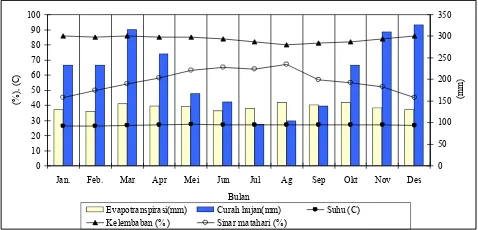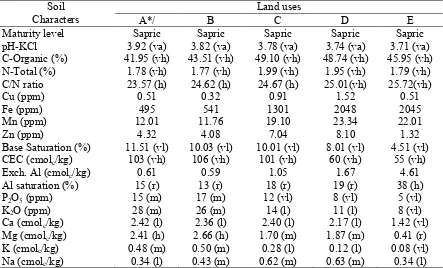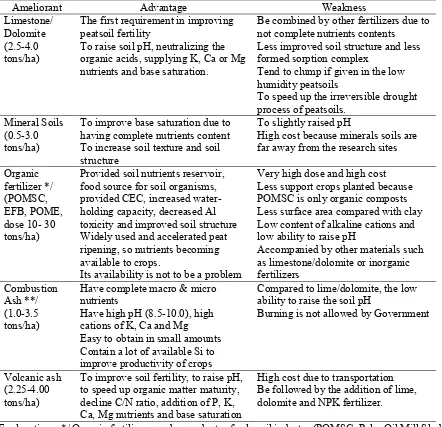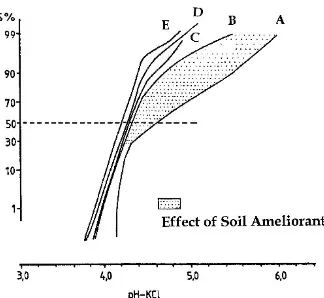Managing Actual Problems of Peatsoils Associated with Soil Acidity
M. Edi Armanto1,*, M.S. Imanudin1, Elisa Wildayana1, Heri Junedi2 and Mohd. Zuhdi3
1Faculty of Agriculture, Sriwijaya University, 30662 Indralaya, South Sumatra 2
Faculty of Agriculture, Jambi University, 36361 Jambi 3Faculty of Forestry, Jambi University, 36361 Jambi
*Corresponding Author: [email protected] Phone/Fax. +62711580460 HP. +628127835268
Article history
Received Received in revised form Accepted Available online
30 August 2016 29 September 2016 1 October 2016 26 November 2016
Abstract: The research objective is to manage actual problems of peatsoils associated with soil acidity. The research
has been conducted on peatsoils in river backswamps located in Subdistricts of East Pedamaran and Pedamaran, District of OKI South Sumatra. Soil sampling was taken in cultivated and uncultivated types of landuse; cultivated peatsoils consist of Site A (intercropping between oil palm and pineapple) and Site B (oil palm), uncultivated peatsoils are divided into Site C (peat forest), Site D (swamp bush) and Site E (swamp grass). The research resulted that actual problems of soil acidity is associated with base saturation, cations exchange capacity, soil organic matters and C/N ratio, balances of soil nutrients, and toxicity potency. The climatic condition and drought can accelerate the occurrence of actual problems of peatsoils associated with acidity peatsoils. Some ameliorant have been applied in order of importance in the fields, namely lime/dolomite, mineral soils, organic fertilizers, combustion ash, and volcanic ash. Application of ameliorant materials is capable to minimize the actual problems of peatsoils associated with soil acidity.
Keywords: Managing, actual problems, peatsoils, acidity
Abstrak (Indonesian): Tujuan penelitian ini adalah untuk mengelola masalah aktual tanah gambut yang terkait
dengan keasaman tanah. Penelitian ini telah dilakukan pada tanah lebak gambut yang terletak di Kecamatan Pedamaran Timur dan Pedamaran, Kabupaten OKI Sumatera Selatan. Contoh tanah diambil berdasarkan jenis penggunaan lahan; untuk tanah gambut yang digarap dibagi menjadi Site A (tumpang sari antara kelapa sawit dan nanas) dan Site B (kelapa sawit), tanah gambut tidak digarap dibagi menjadi Site C (hutan gambut), Site D (rawa semak) dan Situs E (rumput rawa). Hasil penelitian menunjukkan bahwa masalah aktual keasaman tanah dikaitkan dengan kejenuhan basa, kapasitas kation tukar, bahan organik tanah dan C/N rasio, keseimbangan nutrisi tanah, dan potensi toksisitas. Kondisi iklim dan kekeringan dapat mempercepat terjadinya masalah aktual tanah gambut yang terkait dengan keasaman tanah. Amelioran yang telah diterapkan, yaitu kapur/dolomit, tanah mineral, pupuk organik, abu pembakaran, dan abu vulkanik. Bahan amelioran mampu meminimalkan masalah-masalah aktual tanah gambut yang terkait dengan keasaman tanah.
Kata kunci: Mengelola, masalah aktual, tanah gambut, keasaman
1. Introduction
Peatsoils are defined and formed from accumulation of decaying vegetation residues. Vegetation residues accumulates and decomposition process is slow and delayed due to reduction environmental conditions, floods or no environmental support for the decomposition process. Differences between peatsoils and upland soils can be researched from various aspects, namely water resources, management techniques, soil fertility, soil productivity, soil chemical and physical
properties. Peatsoils are found widely in South Sumatra and can be used for agriculture and plantation [1-2].
Field facts showed that since peatsoils have been reclaimed till now, peatsoils area have developed in accordance with the conditions of each region and are likely relatively difficult to control their dynamic changings. This is because the peatsoils are mostly found in the downstreams, then most of the upstream problems will directly affect the dynamics of peatsoils.
Landuse types, that have been planned and organized, showed much changes in physical, chemical and biological aspects. Peatsoils in Sub District of East Pedamaran, OKI District have been reclaimed and showed many limiting factors for growing of food crops, especially for rice, corn and others. The limiting factors can cause low soil productivity; thus it can be concluded that the one of most main challenge of peatsoils reclamation is "less understood of potential soil acidity". Some efforts to neutralize soil acidity, especially in topsoils are categorized as relatively difficult, expensive and needs a comprehensive approach. Proper water management system is very required to achieve optimum soil water depth for crops growth, acid sulphate soils should not be exposed to soil surfaces and excessive drying the peatsoils should not happen. If peatsoils experience serious drought, then peatsoils become sensitively flammable, the release of carbon emissions and soil subsidence.
The first limiting factor, the depths of ground water levels have to be properly controlled, then the second important limiting factor is soil acidity. Soil acidity management is a key to the success of farming in the peatsoils. Peatsoils require serious efforts, the peatsoils can be useful for farmers and the common community. The research objective is to manage actual problems of peatsoils associated with soil acidity.
2. Experimental Sections
The research has been conducted on peatsoils in river backswamps, Sub Districts of East Pedamaran and Pedamaran located in District of OKI South Sumatra. Soil sampling was taken in cultivated and uncultivated types of landuses; cultivated peatsoils consist of Site A (intercropping between oil palm and pineapple) and Site B (oil palm), uncultivated peatsoils are divided into Site C (peat forest), Site D (swamp bush) and Site E (swamp grass). All sampling research sites are presented in Figure 1.
Figure 1. Research sites for soil sampling
Detailed field descriptions and observations were carried out by using a grid system for all research sites, which cut perpendicular to the river channel for observation soil variability in vertical or horizontal direction. Soil sampling was conducted by augering using a peatsoil auger. Soil morphological and field conditions were fully described. Research data were analyzed by using SPSS program version 21.
3. Result and Discussion
Actual problems related to soil acidity can be seen and felt directly by farmers who threaten their agricultural production. Various actual problems associated with soil acidity are base saturation and CEC, organic matter content, soil nutrient balance and toxicity. All above problems are compounded by the drought problem because actual problems related to soil acidity increases due to drought conditions.
Climate and Drought
The study area has a precipitation type of A and B1 agro-climatic zones marked with 7-9 months of continuing wet (> 200 mm) and dry (<100 mm) is less than 3 months, which falls in months of July, August and September. The average annual rainfall is 2,400-3,800 mm, although the amount of rainfall is relatively high, but the rainfall distribution is not evenly distributed throughout the year. Amount of rainfall in 2014 and 2015 was at the lowest level (< 1,900 mm/year) during last 20 years, therefore in these years there have been intensive land and forest fire due to drought conditions. These conditions can be trigger to be occurred the drought (Figure 2).
Figure 2. Analysis of climatic data (JICA Study Team)
The climate data can be divided into wet and dry periods. Some events can be analyzed with respect to water availability for food crops as follows:
3) The dry season is less than two months, it can be said as a wet year, which is found 9 times (29%). 4) The length of the dry period ranges from one month
up nearly 6 months.
5) The most time the dry season has occurred in June, but it had also occurred in May and June.
6) The beginning of the wet season generally falls in October, but it is common that the beginning of the wet season has occurred in September.
According to analysis and experience of farmers, there are some soil problems in term of water availability or drought as follows:
1) The emergence of opportunities in wet or dry year is almost the same, thus it will be difficult for farmers to anticipate the management of food crops in the fields.
2) The period length of the wet season every year is not always the same (ranging from 3-9 months), as well as the dry period length is also changing. Thus it is difficult for farmers in choosing the crop type and determine the cropping period.
3) Often there is a dry period indefinite duration in the middle of the wet season, in which these events can cause interference to the growth of food crops and cause death of food crops.
4) The beginning of the wet season every year is always changing, it makes difficult for farmers in determining the start of the growing season.
Drought often complained by farmers is the cause of production failure in July, August and September. Drought occurs because the water existence in the rooting layer is not available during a certain period. The water stored in the rooting layer is largely derived from rain water into the soils through an infiltration process. The water availability for food crops is determined by two main factors, namely the soil capacity to hold water (porosity and thickness of rooting layers) and the rainfall distribution (continuity of water supply). Although the annual rainfall is high, but all falling rain can be drained out from the rooting layer because soil holding capacity is very limited. In other hand, in the wet season most of ground water is "stagnant" because of poor drainage system and surface flow is inhibited. Thus almost all research sites are flooded by water. Thus, water availability is inhibited by low respiration process and food crops lack of oxygen.
In the dry season, most of the pyrite compounds are oxidized and become triggers the release of H+ ions. During the wet season, the excess water will help and accelerate the distribution of oxidized pyrite to all peatsoils swamp area. It is concluded that soil acidity problems related to water availability becomes very complex because it involves the time dimension, thus uncertainty factors (the frequency of droughts and length of wet periods) become very important factors in the management of soil acidity.
Soil Acidity, Base Saturation and CEC (Cation
Exchange Capacity)
All peatsoils of the five research sites are classified as very acid with a pH (KCl) ranging from 3.71-3.92. The Site A and Site B (cultivated peatsoils have a shallow peat) showed soil pH values higher few units compared with Site C, Site D and Site E (uncultivated peatsoils). The acidity of peatsoils is closely related to the content of organic acids containing from fulvic and humic acids. Peatsoils pH value tends to decrease with depth.
The content of exchangeable alkaline bases (Ca, Mg, K and Na) was low for uncultivated peatsoils and medium to high for cultivated peatsoils. This is due to the ameliorant effect given into the peatsoils. Thick peat layers (uncultivated peatsoils) showed low exchangeable alkaline bases and soil reaction tends to be more acid. It is associated with the formation of thick peatsoils, which are influenced by rainwater.
CEC values in all the peatsoils are very high in the range of 55-106 cmolc/kg. High pH dependent CEC due
to the negative charge that most of the carboxyl and hydroxyl groups of phenolic acids. CEC soils have a positive linear relationship with the organic carbon content (r = 0.86 for uncultivated peatsoils and r = 0.93 for cultivated peatsoils). This means that 86% of the CEC of uncultivated peatsoils is played by soil organic C content, while 93% CEC of cultivated peatsoils was determined by soil organic C. The amount of soil organic C contribution to the CEC on peatsoils cultivated for organic C in cultivated peatsoils is almost perfectly decomposed, so the ability is already decomposed organic C was also high for holding of alkaline base cations.
Soil Organic Matters and C/N Ratio
Organic C content of the uncultivated peatsoils ranged 45.95-49.10%, which was higher than those in cultivated peatsoils (ranging 41.95-43.51%). The uncultivated peatsoils (Site C, Site D and Site E) are still covered with natural vegetation (forest, Site C), shrub and swamp grass (Site D and Site E). General levels of organic matters in the topsoils are still very high. The forests opening for farmland and agriculture resulted in decreased levels of soil organic matter quickly. This is due to mineralization processes of organic matter, which was rapid due to high air temperatures and soil. The decline in organic matter in the topsoils was also caused by harvesting out of the fields on a large scale without return of the residues of the harvest.
because of the inhibited condition. The lower the C/N ratio means that decomposition of soil organic matter is increasing.
Balance of Soil Nutrients
All peatsoils showed that status of soil nutrients is not balanced. Micro nutrients (Cu, Mn and Zn) are classified as very low, except for very high Fe content.
Soil available P and available K are found as very low for uncultivated peatsoils (ranging from 5-12 ppm for P and 8-14 for K) and for cultivated peatsoils are classified as moderate (ranging 15-17 ppm for P and 26-28 ppm for K) due to effects of soil ameliorant applied to cultivated peatsoils. In other word, soil ameliorant is automatically able to increase available P and available K. Balance status of soil nutrients and their soils assessment are summarized in Table 1.
Table 1. Balance status of soil nutrients and their soils assessment*/ Soil
Characters
Land uses
A*/ B C D E
Maturity level Sapric Sapric Sapric Sapric Sapric
pH-KCl 3.92 (va) 3.82 (va) 3.78 (va) 3.74 (va) 3.71 (va)
C-Organic (%) 41.95 (vh) 43.51 (vh) 49.10 (vh) 48.74 (vh) 45.95 (vh) N-Total (%) 1.78 (vh) 1.77 (vh) 1.99 (vh) 1.95 (vh) 1.79 (vh)
C/N ratio 23.57 (h) 24.62 (h) 24.67 (h) 25.01(vh) 25.72(vh)
Cu (ppm) 0.51 0.32 0.91 1.52 0.51
Fe (ppm) 495 541 1301 2048 2045
Mn (ppm) 12.01 11.76 19.10 23.34 22.01
Zn (ppm) 4.32 4.08 7.04 8.10 1.32
Base Saturation (%) 11.51 (vl) 10.03 (vl) 10.01 (vl) 8.01 (vl) 4.51 (vl) CEC (cmolc/kg) 103 (vh) 106 (vh) 101 (vh) 60 (vh) 55 (vh)
Exch. Al (cmolc/kg) 0.61 0.59 1.05 1.67 4.61
Al saturation (%) 15 (r) 13 (r) 18 (r) 19 (r) 38 (h)
P2O5 (ppm) 15 (m) 17 (m) 12 (vl) 8 (vl) 5 (vl)
K2O (ppm) 28 (m) 26 (m) 14 (l) 11 (l) 8 (vl)
Ca (cmolc/kg) 2.42 (l) 2.36 (l) 2.40 (l) 2.17 (l) 1.42 (vl)
Mg (cmolc/kg) 2.41 (h) 2.66 (h) 1.70 (m) 1.87 (m) 0.41 (r)
K (cmolc/kg) 0.48 (m) 0.50 (m) 0.28 (l) 0.12 (l) 0.08 (vl)
Na (cmolc/kg) 0.34 (l) 0.43 (m) 0.62 (m) 0.63 (m) 0.34 (l)
Explanations: */ A (Intercropping between oil palm and pineapple); B (oil palm); C (peat forest); D (swamp bush); E (swamp grass), a (acid), va (very acid), h (high), vh (very high), vl (very low), l (low), m (middle), **/ Soil assessment is based on the general nature of tropical soils [6].
Exchangeable Na is generally low to moderate (0.34-0.63 cmolc/kg). Exchangeable Ca is very low to
low (1.42-2.42 cmolc/kg) and exchangeable Mg is
classified as low to high (0.41-1.70 cmolc/kg for
uncultivated peatsoils and 2.41-2.66 cmolc/kg for
cultivated soil due to application of liming and dolomite. To improve soil nutrient balance, it is clear that the peatsoils need some soil ameliorant that can achieve optimum plant growth.
Toxicity Potency
Toxicity potency is associated with the presence of exchangeable Al and Al saturation. In theory that peatsoils naturally do not show Al toxicity because nature has set the good balance of all nutrients in the peatsoils, but if peatsoils have been reclaimed, then Al will appear to the soil surface. The presence of exchangeable Al in the soil surface causes occurrence of the potential Al toxicity for crop growth because excessive exchangeable Al will lead to increase soil
acidity and damage the rooting system of food crops, especially rooting system of food crops are very vulnerable to appearance of exchangeable Al and high soil acidity.
The exchangeable Al content on uncultivated peatsoils ranged 1.05-4.61 cmolc/kg (classified as high)
and Al saturation is determined as low to high (ranging of between 18-38%). This means that the uncultivated peatsoils are no longer natural and have received a lot of man-intervention through activities of illegal logging, “sonor” system, fishing, shifting cultivation and most of uncultivated peatsoils are streamed by tides from the area that is intervened by the man-made activity.
There was a slight decrease in exchangeable Al (0.59-0.61 cmolc/kg) and Al saturation for cultivated
ppm for uncultivated peatsoils and 495-541 ppm for cultivated peatsoils). The high exchangeable Al, Al saturation and Fe on peatsoils for whole area of peatsoils area because Al and Fe are distributed by the flowing waters (during drainage process), where pyrite are oxidized specifically in the dry season and spread throughout the region during the wet season.
Erosion of topsoils in water canals will increase the seriousness of poisoning Al and Fe dissolution problems because the subsoils layers contain higher Al and Fe and
will be oxidized. The rooting system of food crops is the first part of food crops affected by the Al and Fe toxicity of Al and Fe and soil nutrients uptake will totally be disturbed. Therefore, the rooting system of food crops, which are less resistant to Al and Fe toxicity, are usually unable to normally develop. At the next turn through the processes that occur in the roots will be affected and subsequently also the other parts of food crops can be damaged from the influence of Al and Fe toxicity.
Table 2. Used ameliorant materials in the research sites
Ameliorant Advantage Weakness
Limestone/ Dolomite (2.5-4.0 tons/ha)
The first requirement in improving peatsoil fertility
To raise soil pH, neutralizing the organic acids, supplying K, Ca or Mg nutrients and base saturation.
Be combined by other fertilizers due to not complete nutrients contents
Less improved soil structure and less formed sorption complex
Tend to clump if given in the low humidity peatsoils
To speed up the irreversible drought process of peatsoils.
Mineral Soils (0.5-3.0 tons/ha)
To improve base saturation due to having complete nutrients content To increase soil texture and soil structure
To slightly raised pH
High cost because minerals soils are far away from the research sites
Organic food source for soil organisms, provided CEC, increased water-holding capacity, decreased Al toxicity and improved soil structure Widely used and accelerated peat ripening, so nutrients becoming available to crops.
Its availability is not to be a problem
Very high dose and high cost Less support crops planted because POMSC is only organic composts Less surface area compared with clay Low content of alkaline cations and low ability to raise pH
Accompanied by other materials such as limestone/dolomite or inorganic
Have complete macro & micro nutrients
Have high pH (8.5-10.0), high cations of K, Ca and Mg Easy to obtain in small amounts Contain a lot of available Si to improve productivity of crops
Compared to lime/dolomite, the low ability to raise the soil pH
Burning is not allowed by Government
Volcanic ash (2.25-4.00 tons/ha)
To improve soil fertility, to raise pH, to speed up organic matter maturity, decline C/N ratio, addition of P, K, Ca, Mg nutrients and base saturation
High cost due to transportation Be followed by the addition of lime, dolomite and NPK fertilizer.
Explanations: */ Organic fertilizers are by-products of palm oil industry (POMSC: Palm Oil Mill Sludge Cake). POMSC consist of EFB (Empty Fruit Bunches) and POME (Palm Oil Mill Effluent) and containing 0.5% N, 0.4% P, 0.5% K, 0.8% Ca and 0.3% Mg. **/ Residues of organic materials combustion of wood, trash, weeds, wood saws ash, husk and litter and others
Soil Amelioran Materials
Used ameliorant materials in the research site could be organic and inorganic materials. Some ideal properties of ameliorant materials show high base saturation, can increase soil pH, and contains all the nutrients needed by food crops, beside that they are able
The probability plot of pH-KCl values at different soil depths (N= 198) is given in Figure 3. This frequency analysis is plotted against a sum probability axis. The pH values tend to be higher and are skewed to the right in Site A (oil palm and pineapple), but generally a very narrow pH range is given for all research sites due to the special buffering system of the high organic acid (among other fulvic and humic acids) predominating in these peatsoils.
Figure 3. Probability plot of pH values in five soils A (Intercropping between oil palm and pineapple); B
(oil palm); C (peat forest); D (swamp bush); E (swamp grass)
The importance of ameliorant materials in topsoils for the enhancement of the fertility and liming is revealed by the wide pH-KCl range in soils of 0-20 cm depth. Only with the assistance of ameliorant materials may liming rise the pH of these acidified peatsoils above a pH of more than 5. The impact of ameliorant materials for increasing soil pH is given in Figure 3.
4. Conclusion
Based on these research results and discussions, thus some conclusions can be drawn as follows:
1) Actual problems of soil acidity are associated with base saturation, cations exchange capacity, soil organic matters and C/N ratio, balances of soil nutrients, and toxicity potency
2) The climatic condition and drought can accelerate the occurrence of actual problems of Peatsoils associated with acidity peatsoils
3) Some ameliorant has been applied in order of importance in the fields, namely lime/dolomite, mineral soils, organic fertilizers, combustion ash, and volcanic ash
4) Application of ameliorant materials is capable to minimize the actual problems of peatsoils associated with soil acidity.
Acknowledgement
The authors would like to say a lot of thanks to the University of Sriwijaya, which has provided research funding through the research scheme “Penelitian
Unggulan Profesi Dosen” Sriwijaya University with the research contract of Nr. 1023/UN9.3.1/LPPM/2016 dated July 18, 2016.
References
[1]RePPProt. Review of phase 1 results, Sumatra, from Regional Physical Planning Programme for Transmigration (RePPProt). Land Resources Department ODNRI, London, England and Direktorat Jenderal Penyiapan Pemukiman, Departemen Transmigrasi, Jakarta. 1990.
[2]S.M. Ismail, S. Gandaseca and O.H. Ahmed. “Effects of Deforestation on Soil Major Macro-Nutrient and Other Selected Chemical Properties of Secondary Tropical Peat Swamp Forest”. Int. J. Physic. Sci. Vo. 7: 2225-2228. DOI: 10.5897/ IJPS11.596. 2012. [3]M. Könönen, J. Jauhiainen, R. Laiho, K. Kusin and
H. Vasander. “Physical and Chemical Properties of Tropical Peat under Stabilized Land Uses”. Mires and Peat, Vol 16(8); 1-13. 2015.
[4]S. Ritung, Wahyunto, K. Nugroho, Sukarman, Hikmatullah, and Suparto abd T. Chendy. “Peatland Map of Indonesia, Scale 1:250.000”. Dec. 2011 Edition. Center for Agricultural Land Resource Research and Development, Agency for Agricultural Research and Development, Bogor. 2011.
[5]M.I. Salimin, S. Gandaseca, O.H. Ahmed and N.M.A. Majid. “Comparison of Selected Chemical Properties of Peat Swamp Soil before and after Timber Harversting”. Am. J. Environ. Sci. Vol 6: 164-167. 2010.
[6]PPT. “Terms of Reference Tipe A; Survai Kapabilitas Tanah”. Proyek Penelitian Pertanian Menunjang Transmigrasi (P3MT), Badan Litbang Pertanian,



